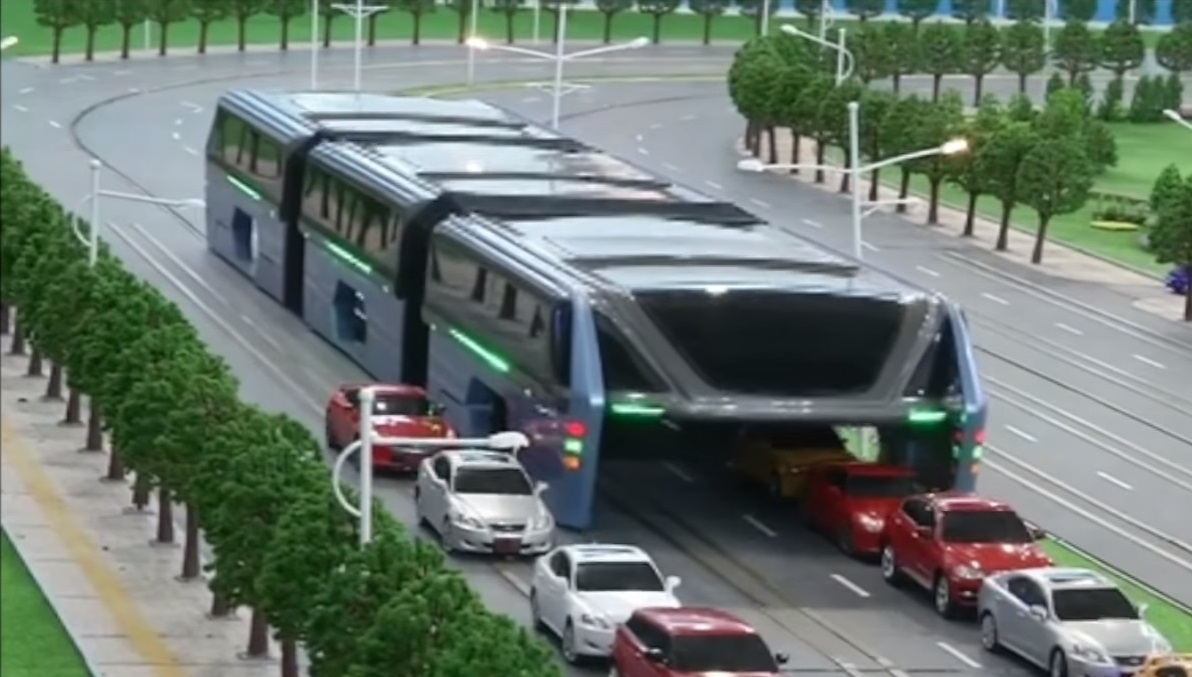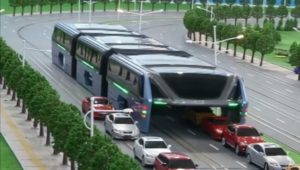The Transit Elevated Bus
The Transit Elevated Bus
Ever spotting a frustrating problem in your daily life? While you are still silently enduring the inconvenience it brings, some sagacious minds have been trying to solve it. As trafic problems haunt cities all over the world, a novel bus design recently presented in front of the public sheds a beam of refreshing light on the problem.
Early this year in May, on the 19th China Beijing International High-tech Expo, inventor Youzhou Song published a intriguing design of a “tunnel-shaped” bus. The design is named “Transit Elevated Bus”. With a wide body spanning the road, the electric-powered bus travels on railroads that are built alongside the normal driveways. Functioning similarly as subways, it operates in a seperated transportation system. It is designed with a hollow space under its body that allows cars with height below 2 meters to pass freely and a total height no more than 4.5 meters concerning bridges and street lights. The bus thus avoids competing driving spaces with private cars to address the trafic problem. Besides, the bus is covered with solar panels on its large roof to gain sufficient power, estimately saving 800 tons of feuls and reducing 1500 tons of carbon-dioxide emition per year. With a capacity of 1200, it can also replace 40 regular buses. Moreover, the cost of manufacturing an elevated bus is around one fifth of that of a subway train.
The design evokes great interest worldwide, for few have ever come up with such an innovative idea. However, as happpened to all designs, questions have been raised against the Transit Elevated Bus.
Firstly, because the huge bus estimately posseses the same weight as a train carriage, to protect the surface of the roads, the rails should be placed upon railway sleepers, which would take up much space. Secondly, since the space under the bus is designed to be rectangular, the bus should be designed with extremely clever supporting structure to hold up its body.Thirdly, it could be very dangerous when the bus or the cars beneath are steering to a different direction, and if a collision happens, the road both “above” and beneath will be easily blocked. At the same time, new trafic laws concerning the responsibility of the drivers involved in such accidents will be difficult to impliment due to the situation. Futher, there is no need for such a vast capacity for one route of transportation inside the city. Sixthly, if the bus catght fire, it may cause great casulties for the design adopts slide escape plans, but slides require much space. Travelling in the city, no one can guarantee that when a emergency happens, the bus fortunately stops at places with sufficient free area around its tracks. And finally, it will stop vehicles that are higher than 2 meters, such as container trucks and will consequently add to more trafic problems.
Anyway, the design truly did enlighten us of finding new approaches to a problem. Whether it is feasible or not, the innovative spirit behind the design should be acclaimed. It is the propencity of one to observe and contemplate that ignites the advancement of the society. Instead of managing to challenge a new idea, let’s welcome and support all innovations with a objective mind.
http://www.ibtimes.co.uk/chinas-futuristic-hover-bus-takes-unique-approach-traffic-jams-by-gliding-over-them-1561963
Zhenlin Kan





